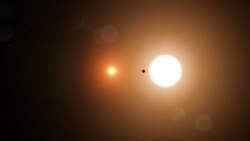Call it luck, but not “dumb luck.”
Just three days into Wolf Cukier’s summer internship with the American space agency NASA, he found a new planet.
The 17-year-old high school student was tasked with looking through data from a telescope in search of evidence of planets outside our solar system.
“I was pretty much spending my summer looking at graphs on a computer screen.”
And on his third day with NASA, Cukier found it -- a previously unknown planet orbiting two stars.
Cukier was looking at data produced by NASA’s Transiting Exoplanet Survey Satellite, known as TESS. Although he did not see the physical planet, he saw clear evidence of it.
“I couldn't say that I was confident it was a planet because it was day three on the job. And I couldn't say anything with confidence quite yet. But out of the hundred different targets that I looked at, I remember I put about 10 asterisks next to this one, saying this one looks good, we should look at this one first.”
The planet is 1,300 light years from Earth.
What Cukier had found was evidence of changes in the light of the two stars, called binary stars. The way scientists “see” such a distant planet is by changes in light. If a planet is moving between the telescope and the star it orbits, it produces an effect similar to an eclipse that we see here on Earth.
In other words, the planet blocks some of the sun’s light from the telescope. In graphs and other data, this shows up as a dip -- a line that moves down and then up again.
Later that day, Cukier met with his boss, Veselin Kostov, to go over his find.
The high school student was working with a team of scientists at NASA’s Goddard Space Flight Center in Maryland, not far from Washington, D.C.
NASA has about 2,000 interns across the country each year.
Kostov told VOA that Cukier came into his office and told him he had something that “looks interesting.”
It was “a really exciting couple of hours” to make sure what they saw “was real,” Kostov said.
“Once we were pretty confident that they were mostly real, we reached out to the rest of the team,” Kostov said. Other team members found more transits of the planet, giving them more evidence.
Because the planet is so big, NASA scientists believe it is made of gas, like Saturn or Jupiter. Even if it had been rocky, like Earth, the planet seems to be too close to one of the stars to be able to support life.
A team of NASA scientists, including Cukier, submitted the finding to a scientific journal. The work will be published soon.
Reading scientific journals in his classes at Scarsdale High School in New York is what brought Cukier to his internship at NASA. Under the supervision of two high school teachers, he and other students in the program study a science field of their choice. Cukier settled on the field of astrobiology.
He contacted people at NASA to help him gain an internship. While at NASA in the summer of 2018, he studied “Goldilocks” zones—planets that have conditions that could support life.
NASA invited Cukier back the following summer. And that is when he found the planet.
NASA’s Kostov holds a doctoral degree from Johns Hopkins University. Both he and Cukier have advice for students wanting to study the stars. First, study physics and math.
Other than that, Cukier says it was both luck and “putting in the hard work” that led to his discovery.
“Yes what I did is impressive, but it also didn't take that many special skills. So, if someone is interested in science, like my age, and even if they don't have training, they should still just reach out to researchers and find something that they can do because almost anyone can look through data looking for dips.
“It just happened to be me, who saw this one.”
Since the news broke earlier this month, Cukier has told his story to many media organizations. He says that even though it has been fun, the attention is a “bit overwhelming.”
As for his future, Cukier plans to study either physics or astrophysics in college. He hopes to attend Stanford, Princeton or M.I.T., the Massachusetts Institute of Technology next autumn.
But first comes his high school graduation this spring.
I’m Anne Ball.
Anne Ball wrote this story for Learning English. Ashley Thompson was the editor.
What do you think of this story? Would you like to study the stars? Write to us in the comments section below.
______________________________________________________________
Words in This Story
dumb luck – n. informal saying meaning something good happens completely by chance without being planned or deserved
internship – n. a position as an intern to learn on the job
solar system – n. our sun and planets moving around it
graph – n. a drawing that uses a series of dots and lines to show how much or quickly something changes
confident – adj. having a feeling or belief that you can do something well or succeed at something : having confidence
asterisk – n. a symbol * that is used in printed text that can signal importance
eclipse – n. an occasion when the sun looks like it is completely or partially covered with a dark circle because the moon is between the sun and the Earth
impressive – adj. deserving attention, admiration, or respect : making a good impression
overwhelming – adj. very great in number, effect, emotions or force











